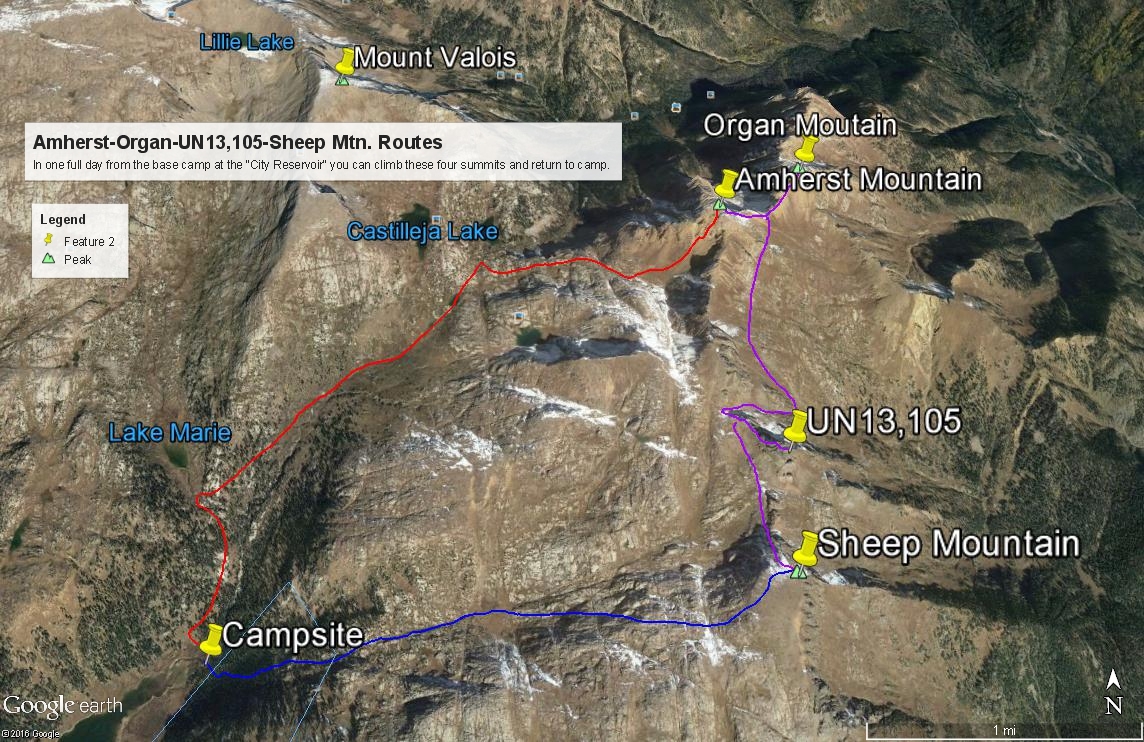From the proposed base camp at the NE end of City Reservoir #1, head north on the trail up to Lake Marie hiking steeply up the forested drainage. In the vicinity of where the USGS map indicates to site of "Logtown," cross the creek to the NE. In 2006, we found a rock cairn marking a place to cross the stream where it passes over some rocks. After crossing, we bushwhacked up steeply through some willows on a fairly well-defined trail that showed passage of horses recently. The trail eventually took us on the east side of the creek that drains Castilleja Lake (Durango Reservoir #4). We passed a nice campsite on the way up along this stream in the open area that the map shows NE of Logtown. In the upper reaches of the valley, the trail fades away, but hiking is easy and quick across tundra and grass. Walk on past the three small tarns south of the two larger, unnamed lakes. Just before where this valley drops off steeply to the north, contour east and work your way over into another large valley/basin that heads eastward to Amherst. This basin will also be filled with tundra and grass until you come below the SW face of Amherst. The upper end of the basin becomes mostly broken rock.
At the time we made this climb, the only beta we had was the 'Guide To the Colorado Mountains" which said to "hike" up the SW face of Amherst, then to continue over to Organ. That was certainly an understatement. The word "Hike" is not an adequate description for the rocky and steep SW face. From here, note that there are two basic ways to the summit that we will mention. Looking over to the south ridge of Amherst, you'll notice a significant notch with a reddish gully that runs up to the notch. "Furthermore" on LoJ went up that gully to the notch, rating it a 3rd class scramble, but did not proceed up the south ridge, Instead, he angled over to the Amherst/Organ saddle and climbed Organ first, then went back to the saddle and ascended Amherst by its east ridge. His account is not very clear as to how he descended Amherst, but it sounds as though he descended the south ridge back to the notch. He does not mention anything harder than 3rd class. We did not choose to go that way, but our notes observe that the notch and the south ridge would have been easier than how we went.
The route we took went directly up the SW face. We walked up a moderately steep runout slope until it steepened and we began to scramble up the main face. We headed in the general direction of a dark, almost black crack, staying to the left generally. At one point we found ourselves navigating a steep, sloping shelf covered with loose gravel. We actually used a short piece of rope here to belay each other up this shelf with one of us taking the lead ascending a short, but near vertical step to another shelf from which a belay could be offered. This was only for a few feet, but this was the crux, 4th class section. The rope was mainly used because of the loose gravel. The upper shelf really offered nothing to belay from. Once above this crux, things eased up a bit. A little further up, we found a steep ramp leading right that brought us out on the south ridge, and east flank of the peak, just below the summit for a more pleasant finish. Looking back down the south ridge to the notch mentioned earlier confirmed to us that the notch and south ridge/east flank combo would have been simpler. This is one of those cases where we do not recommend our own route.
From the summit, you'll enjoy a good view over to Organ Mountain which pairs very nicely with Amherst if time and weather allows. There's also a great view looking across Johnson Creek to McCauley and Grizzly.
Links to other information, routes & trip reports for this peak that may be helpful.
 N 37° 33' 54.59", W 107° 33' 33.92"
(Not Field Checked)
N 37° 33' 54.59", W 107° 33' 33.92"
(Not Field Checked)
